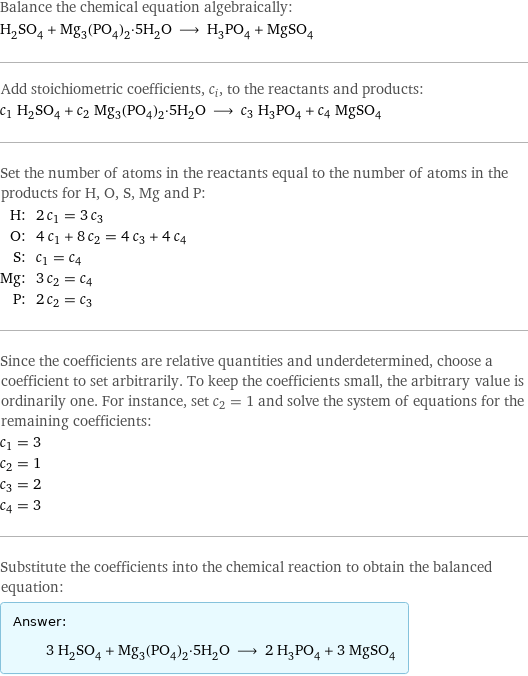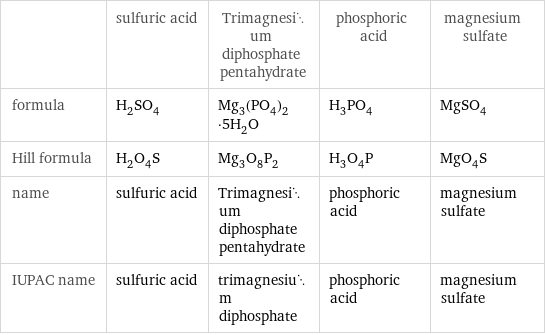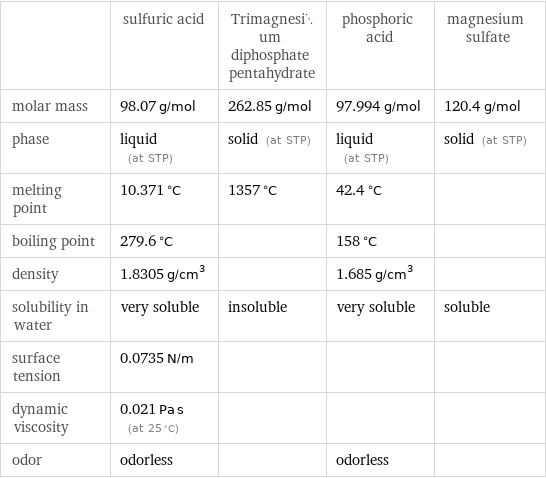Input interpretation

H_2SO_4 sulfuric acid + Mg_3(PO_4)_2·5H_2O Trimagnesium diphosphate pentahydrate ⟶ H_3PO_4 phosphoric acid + MgSO_4 magnesium sulfate
Balanced equation

Balance the chemical equation algebraically: H_2SO_4 + Mg_3(PO_4)_2·5H_2O ⟶ H_3PO_4 + MgSO_4 Add stoichiometric coefficients, c_i, to the reactants and products: c_1 H_2SO_4 + c_2 Mg_3(PO_4)_2·5H_2O ⟶ c_3 H_3PO_4 + c_4 MgSO_4 Set the number of atoms in the reactants equal to the number of atoms in the products for H, O, S, Mg and P: H: | 2 c_1 = 3 c_3 O: | 4 c_1 + 8 c_2 = 4 c_3 + 4 c_4 S: | c_1 = c_4 Mg: | 3 c_2 = c_4 P: | 2 c_2 = c_3 Since the coefficients are relative quantities and underdetermined, choose a coefficient to set arbitrarily. To keep the coefficients small, the arbitrary value is ordinarily one. For instance, set c_2 = 1 and solve the system of equations for the remaining coefficients: c_1 = 3 c_2 = 1 c_3 = 2 c_4 = 3 Substitute the coefficients into the chemical reaction to obtain the balanced equation: Answer: | | 3 H_2SO_4 + Mg_3(PO_4)_2·5H_2O ⟶ 2 H_3PO_4 + 3 MgSO_4
Structures

+ ⟶ +
Names

sulfuric acid + Trimagnesium diphosphate pentahydrate ⟶ phosphoric acid + magnesium sulfate
Equilibrium constant
![Construct the equilibrium constant, K, expression for: H_2SO_4 + Mg_3(PO_4)_2·5H_2O ⟶ H_3PO_4 + MgSO_4 Plan: • Balance the chemical equation. • Determine the stoichiometric numbers. • Assemble the activity expression for each chemical species. • Use the activity expressions to build the equilibrium constant expression. Write the balanced chemical equation: 3 H_2SO_4 + Mg_3(PO_4)_2·5H_2O ⟶ 2 H_3PO_4 + 3 MgSO_4 Assign stoichiometric numbers, ν_i, using the stoichiometric coefficients, c_i, from the balanced chemical equation in the following manner: ν_i = -c_i for reactants and ν_i = c_i for products: chemical species | c_i | ν_i H_2SO_4 | 3 | -3 Mg_3(PO_4)_2·5H_2O | 1 | -1 H_3PO_4 | 2 | 2 MgSO_4 | 3 | 3 Assemble the activity expressions accounting for the state of matter and ν_i: chemical species | c_i | ν_i | activity expression H_2SO_4 | 3 | -3 | ([H2SO4])^(-3) Mg_3(PO_4)_2·5H_2O | 1 | -1 | ([Mg3(PO4)2·5H2O])^(-1) H_3PO_4 | 2 | 2 | ([H3PO4])^2 MgSO_4 | 3 | 3 | ([MgSO4])^3 The equilibrium constant symbol in the concentration basis is: K_c Mulitply the activity expressions to arrive at the K_c expression: Answer: | | K_c = ([H2SO4])^(-3) ([Mg3(PO4)2·5H2O])^(-1) ([H3PO4])^2 ([MgSO4])^3 = (([H3PO4])^2 ([MgSO4])^3)/(([H2SO4])^3 [Mg3(PO4)2·5H2O])](../image_source/c3c92446e46fa00355a81438af7709ec.png)
Construct the equilibrium constant, K, expression for: H_2SO_4 + Mg_3(PO_4)_2·5H_2O ⟶ H_3PO_4 + MgSO_4 Plan: • Balance the chemical equation. • Determine the stoichiometric numbers. • Assemble the activity expression for each chemical species. • Use the activity expressions to build the equilibrium constant expression. Write the balanced chemical equation: 3 H_2SO_4 + Mg_3(PO_4)_2·5H_2O ⟶ 2 H_3PO_4 + 3 MgSO_4 Assign stoichiometric numbers, ν_i, using the stoichiometric coefficients, c_i, from the balanced chemical equation in the following manner: ν_i = -c_i for reactants and ν_i = c_i for products: chemical species | c_i | ν_i H_2SO_4 | 3 | -3 Mg_3(PO_4)_2·5H_2O | 1 | -1 H_3PO_4 | 2 | 2 MgSO_4 | 3 | 3 Assemble the activity expressions accounting for the state of matter and ν_i: chemical species | c_i | ν_i | activity expression H_2SO_4 | 3 | -3 | ([H2SO4])^(-3) Mg_3(PO_4)_2·5H_2O | 1 | -1 | ([Mg3(PO4)2·5H2O])^(-1) H_3PO_4 | 2 | 2 | ([H3PO4])^2 MgSO_4 | 3 | 3 | ([MgSO4])^3 The equilibrium constant symbol in the concentration basis is: K_c Mulitply the activity expressions to arrive at the K_c expression: Answer: | | K_c = ([H2SO4])^(-3) ([Mg3(PO4)2·5H2O])^(-1) ([H3PO4])^2 ([MgSO4])^3 = (([H3PO4])^2 ([MgSO4])^3)/(([H2SO4])^3 [Mg3(PO4)2·5H2O])
Rate of reaction
![Construct the rate of reaction expression for: H_2SO_4 + Mg_3(PO_4)_2·5H_2O ⟶ H_3PO_4 + MgSO_4 Plan: • Balance the chemical equation. • Determine the stoichiometric numbers. • Assemble the rate term for each chemical species. • Write the rate of reaction expression. Write the balanced chemical equation: 3 H_2SO_4 + Mg_3(PO_4)_2·5H_2O ⟶ 2 H_3PO_4 + 3 MgSO_4 Assign stoichiometric numbers, ν_i, using the stoichiometric coefficients, c_i, from the balanced chemical equation in the following manner: ν_i = -c_i for reactants and ν_i = c_i for products: chemical species | c_i | ν_i H_2SO_4 | 3 | -3 Mg_3(PO_4)_2·5H_2O | 1 | -1 H_3PO_4 | 2 | 2 MgSO_4 | 3 | 3 The rate term for each chemical species, B_i, is 1/ν_i(Δ[B_i])/(Δt) where [B_i] is the amount concentration and t is time: chemical species | c_i | ν_i | rate term H_2SO_4 | 3 | -3 | -1/3 (Δ[H2SO4])/(Δt) Mg_3(PO_4)_2·5H_2O | 1 | -1 | -(Δ[Mg3(PO4)2·5H2O])/(Δt) H_3PO_4 | 2 | 2 | 1/2 (Δ[H3PO4])/(Δt) MgSO_4 | 3 | 3 | 1/3 (Δ[MgSO4])/(Δt) (for infinitesimal rate of change, replace Δ with d) Set the rate terms equal to each other to arrive at the rate expression: Answer: | | rate = -1/3 (Δ[H2SO4])/(Δt) = -(Δ[Mg3(PO4)2·5H2O])/(Δt) = 1/2 (Δ[H3PO4])/(Δt) = 1/3 (Δ[MgSO4])/(Δt) (assuming constant volume and no accumulation of intermediates or side products)](../image_source/53b85b232bcb29522141f8ccc0c66c2b.png)
Construct the rate of reaction expression for: H_2SO_4 + Mg_3(PO_4)_2·5H_2O ⟶ H_3PO_4 + MgSO_4 Plan: • Balance the chemical equation. • Determine the stoichiometric numbers. • Assemble the rate term for each chemical species. • Write the rate of reaction expression. Write the balanced chemical equation: 3 H_2SO_4 + Mg_3(PO_4)_2·5H_2O ⟶ 2 H_3PO_4 + 3 MgSO_4 Assign stoichiometric numbers, ν_i, using the stoichiometric coefficients, c_i, from the balanced chemical equation in the following manner: ν_i = -c_i for reactants and ν_i = c_i for products: chemical species | c_i | ν_i H_2SO_4 | 3 | -3 Mg_3(PO_4)_2·5H_2O | 1 | -1 H_3PO_4 | 2 | 2 MgSO_4 | 3 | 3 The rate term for each chemical species, B_i, is 1/ν_i(Δ[B_i])/(Δt) where [B_i] is the amount concentration and t is time: chemical species | c_i | ν_i | rate term H_2SO_4 | 3 | -3 | -1/3 (Δ[H2SO4])/(Δt) Mg_3(PO_4)_2·5H_2O | 1 | -1 | -(Δ[Mg3(PO4)2·5H2O])/(Δt) H_3PO_4 | 2 | 2 | 1/2 (Δ[H3PO4])/(Δt) MgSO_4 | 3 | 3 | 1/3 (Δ[MgSO4])/(Δt) (for infinitesimal rate of change, replace Δ with d) Set the rate terms equal to each other to arrive at the rate expression: Answer: | | rate = -1/3 (Δ[H2SO4])/(Δt) = -(Δ[Mg3(PO4)2·5H2O])/(Δt) = 1/2 (Δ[H3PO4])/(Δt) = 1/3 (Δ[MgSO4])/(Δt) (assuming constant volume and no accumulation of intermediates or side products)
Chemical names and formulas

| sulfuric acid | Trimagnesium diphosphate pentahydrate | phosphoric acid | magnesium sulfate formula | H_2SO_4 | Mg_3(PO_4)_2·5H_2O | H_3PO_4 | MgSO_4 Hill formula | H_2O_4S | Mg_3O_8P_2 | H_3O_4P | MgO_4S name | sulfuric acid | Trimagnesium diphosphate pentahydrate | phosphoric acid | magnesium sulfate IUPAC name | sulfuric acid | trimagnesium diphosphate | phosphoric acid | magnesium sulfate
Substance properties

| sulfuric acid | Trimagnesium diphosphate pentahydrate | phosphoric acid | magnesium sulfate molar mass | 98.07 g/mol | 262.85 g/mol | 97.994 g/mol | 120.4 g/mol phase | liquid (at STP) | solid (at STP) | liquid (at STP) | solid (at STP) melting point | 10.371 °C | 1357 °C | 42.4 °C | boiling point | 279.6 °C | | 158 °C | density | 1.8305 g/cm^3 | | 1.685 g/cm^3 | solubility in water | very soluble | insoluble | very soluble | soluble surface tension | 0.0735 N/m | | | dynamic viscosity | 0.021 Pa s (at 25 °C) | | | odor | odorless | | odorless |
Units
